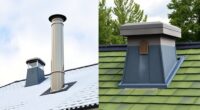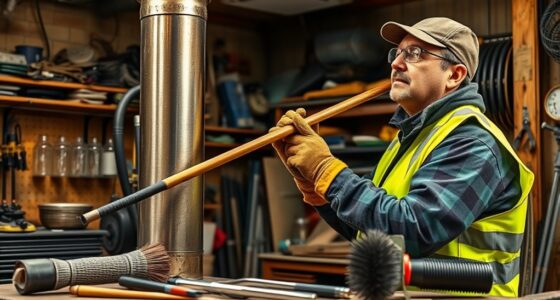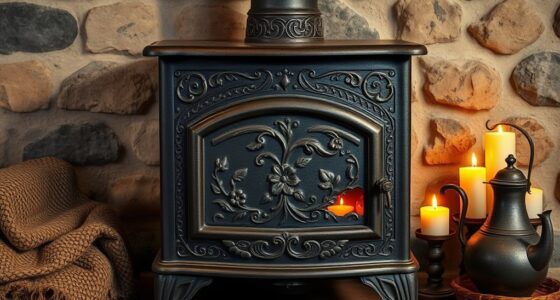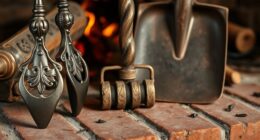To build a wood storage shed that keeps your firewood dry, prioritize proper ventilation by placing vents near the roofline and at the base to promote airflow and prevent moisture buildup. Use durable, rot-resistant materials like pressure-treated lumber or cedar, and elevate the shed on a concrete or treated wood foundation to improve drainage. Incorporate adjustable vents for seasonal control, and guarantee the design protects against rain and pests. Continue exploring for detailed tips on creating an effective, long-lasting firewood shed.
Key Takeaways
- Place vents near the roofline and base for effective natural airflow to keep firewood dry.
- Use rot-resistant materials like pressure-treated lumber or cedar for durability.
- Elevate the shed on a concrete slab or treated wood foundation to prevent ground moisture intrusion.
- Incorporate adjustable vents to control airflow seasonally, reducing humidity in summer and retaining warmth in winter.
- Seal around corners and joints to prevent pests and moisture entry while ensuring proper ventilation.

Have you ever wondered how to create a sturdy, functional wood storage shed that keeps your tools and firewood organized? The key to a successful design lies in focusing on effective ventilation design and choosing the right materials. Proper ventilation is essential to prevent moisture buildup, which can lead to mold, rot, and decay, ruining your firewood and damaging your shed over time. When planning your shed, incorporate vents near the roofline and at the base to promote air circulation. This airflow helps keep the interior dry by allowing moisture to escape, especially during humid or rainy seasons. Avoid sealing your shed completely; instead, ensure there are small gaps or vents that facilitate continuous airflow without letting rainwater seep inside.
Effective shed ventilation with vents at the roofline and base prevents moisture buildup and prolongs durability.
Material selection plays a crucial role in building a durable and weather-resistant shed. Opt for high-quality, rot-resistant materials like pressure-treated lumber, cedar, or composite wood, which can withstand exposure to the elements. These materials are less prone to warping, splitting, or rotting, ensuring your shed remains sturdy for years. When choosing siding, consider using weather-resistant options such as vinyl panels, metal siding, or treated wood with a protective sealant. The roof material should also be durable; metal roofing or asphalt shingles provide excellent protection against rain and snow while lasting longer than cheaper alternatives.
Additionally, the foundation you choose influences the overall longevity and stability of your shed. A concrete slab or pressure-treated wood foundation raises the structure off the ground, helping prevent moisture intrusion from the ground up. Elevating your shed also improves ventilation underneath, further reducing moisture-related issues inside. When assembling the shed, pay close attention to sealing gaps around corners and joints, as these are common entry points for moisture and pests.
Incorporate adjustable vents or louvered vents to control airflow based on seasonal needs. During winter, you might want to reduce airflow slightly to keep the interior warmer, while in summer, increased ventilation helps keep the space cool and dry. Remember, the goal is to create an environment that promotes air circulation without exposing your firewood to excessive moisture or pests. Proper ventilation design is essential for maintaining the quality of your firewood in your shed.
Frequently Asked Questions
How Can I Prevent Pests From Invading My Firewood?
To prevent pests from invading your firewood, you should focus on pest prevention and rodent proofing your storage area. Keep your firewood elevated off the ground and cover it with a tight-fitting, pest-resistant lid. Store it in a well-ventilated shed or container, and avoid stacking it directly against your home. Regularly inspect and remove any infested wood to stop pests from spreading.
What Are the Best Materials for a Durable Shed?
You should choose treated lumber or metal for a durable shed, as these materials withstand weather and pests better. Investigate whether wood treatment truly prevents rot and pests, which it often does when properly applied. Make certain your shed has good ventilation systems to keep the firewood dry and prevent mold. These materials and features will help your shed last longer and keep your firewood in prime condition.
How Should I Arrange Firewood Inside the Shed?
You should arrange firewood inside your shed using proper firewood stacking techniques to guarantee stability and efficient drying. Stack the logs in a crisscross pattern or parallel rows with space between them for good airflow. Incorporate ventilation strategies like vents or gaps in the walls to promote air circulation, preventing moisture buildup. Keep the wood off the ground on pallets or racks to avoid dampness and maintain dryness.
What Maintenance Is Required for the Shed Over Time?
You need to regularly inspect your shed for weatherproofing issues like leaks or cracks, sealing them promptly to prevent moisture damage. Keep an eye out for pests, and apply pest control measures if you notice signs of infestation. Clean out debris and ensure proper ventilation to maintain dry, pest-free firewood storage. Doing these simple maintenance tasks will extend your shed’s lifespan and keep your firewood dry and ready to burn.
Can I Build a Shed on Uneven or Sloped Ground?
Building a shed on uneven ground is like balancing a delicate scale—you’ll face foundation challenges and slope considerations. You can do it, but you need to level the ground first or build a sturdy foundation like concrete blocks or a skid pad. Make certain the shed’s floor is level to prevent firewood from shifting. Proper planning and adjustments help you create a stable, durable storage space even on sloped terrain.
Conclusion
Now that you’ve built your wood storage shed, you’ll enjoy easy access to dry firewood whenever you need it. Properly stored wood not only heats better but also lasts longer. Are you ready to stay warm all winter with your own DIY solution? With just a little effort, you’ve created a functional, durable space that keeps your firewood dry and ready to use. So, why wait? Start stacking and enjoy the cozy comfort your new shed provides.











